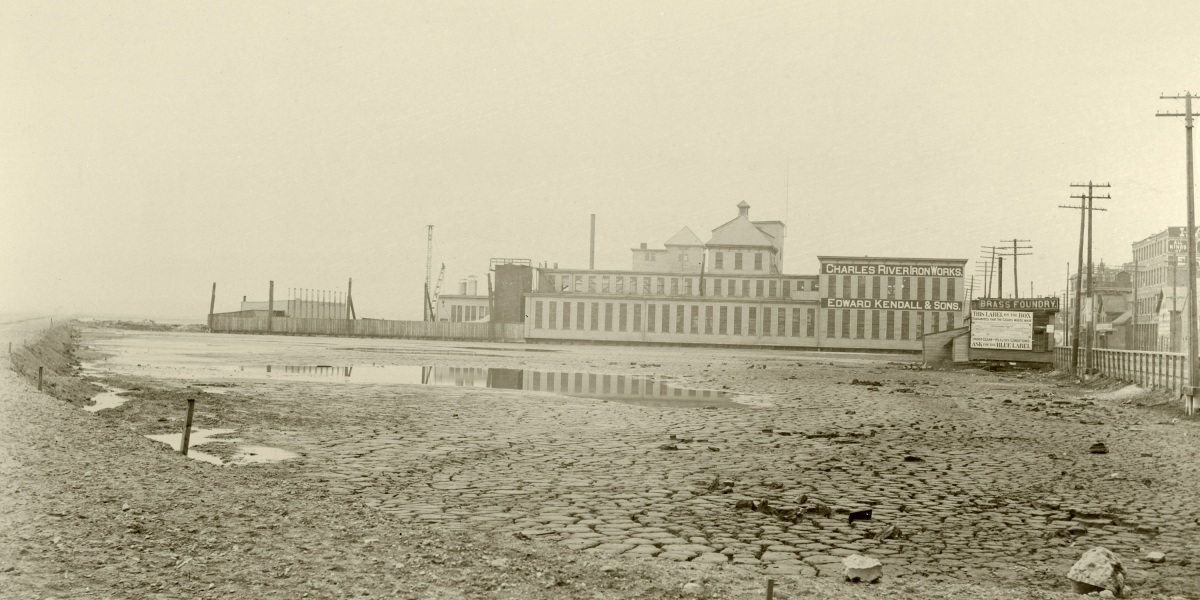
Maclaurin was not dissuaded. A formal new hunt for an expansion site launched with four main criteria: accessibility for students, faculty, and the public; affordability; space, with the potential for constructing buildings “worthy of the institute’s importance”; and a location “independent of the influence of other institutions.” The selection committee’s report, submitted to Maclaurin in October 1910, noted that the committee had considered at least 24 sites, even evaluating the possibility of building an island for the campus in the middle of the Charles, where the Harvard Bridge crossed it (this was soon deemed impractical). The most promising was a long stretch in Boston’s Fenway/Longwood area near the current Harvard Medical School campus and Simmons College. The esplanade site, called the Riverbank in the study, was a distant second, with a laundry list of potential problems. The report pointed out that the land was relatively costly and had a lot of owners—35, as it turned out—with whom to negotiate. The “encroaching manufacturing district” was deemed worrisome, as was the nearness to Harvard and that school’s potential objection to the move. Finally came the concerns about losing the school’s tax-exempt status.
In December, when Maclaurin tested the waters for a donation for any new site from Andrew Carnegie, “as Scotsman to Scotsman,” Carnegie turned him down flat: “Ye’re no blate. Just think of it, I hav given $3,800,000 towards extending the Pittsburg school … and you ask me to help Boston, which has received $400,000 from me for the Franklin Institute! I enjoy the joke! Besides, I do not put the Pittsburg school behind even the Massachusetts Institute of Technology. It is a close race and we’ll see who is winner by and by.” Carnegie even pushed again for the merger with Harvard in a blunt P.S.: “If I mistake not, I am a part owner of that ground that my friend Lee Higginson and some of us purchased to unite the two institutions, which should be done.”
Maclaurin did get a pledge of $500,000 from T. Coleman du Pont, an MIT graduate and future US senator who was then president of his family’s namesake chemical business. But it was for a different site, a golf course in Allston. So perhaps in an effort to stir the pot, Maclaurin casually remarked to a newspaper reporter that “Technology might have to pull up stakes and move to someplace where the cost of living is within its means.”
Several Massachusetts cities quickly expressed their interest. A group of MIT alumni from Springfield offered land there, for example. Cities in other states weighed in as well. The Chicago Evening Post boasted: “We could support a ‘Boston Tech’ with our loose change, and we wouldn’t, like some cities we know of, have to search all the hinterland roundabout to find the money.”
The competition stirred officials in Cambridge to take action. “Restive at being rated as the only city in the state which Technology would never, never consider,” as Maclaurin’s biographer wrote, it dropped any objection to MIT’s retaining its tax-exempt status. The Cambridge City Council passed a formal resolution supporting the relocation, which was forwarded to Maclaurin by the mayor with his personal endorsement. In March 1911, Harvard notified Maclaurin it was now also okay with having both institutions in Cambridge.
All this helped vault the Riverbank property to the top of the list—and loosen purse strings. Du Pont amended his pledge to extend it to the Cambridge property, and the state legislature approved a bill authorizing a grant of $100,000 a year to MIT for 10 years if the school raised a similar amount itself. By the fall of 1911, negotiations had been completed with all 35 owners of the Riverbank area to buy 46 acres of land bounded by Massachusetts Avenue on the west and Ames Street on the east, Vassar Street inland or north, and the esplanade. The envisioned campus did not extend east past Ames Street toward Main Street, where the MIT Media Lab and the MIT Sloan School of Management, among other buildings, stand today. Similarly, the land southwest of Massachusetts Avenue—now home to Kresge Auditorium, many student dorms (including the converted Riverbank Court Hotel), and the athletic center—was not part of the initial purchase. The price tag for the 46 acres was $775,000.
Then, in early 1912, Maclaurin met with Eastman Kodak founder George Eastman (who was neither an MIT alum nor a Massachusetts resident) at the Hotel Belmont in New York. They reportedly had a warm and earnest conversation, in which the MIT president detailed the plans for New Technology. As Maclaurin’s wife, Alice, later related, “The ground was broken so completely in Mr. Eastman’s mind that my husband was astonished. When Mr. Eastman was about to leave, he suddenly asked: ‘What will it cost to put up the new buildings?’ My husband answered that it would cost about two and a half million dollars. Mr. Eastman said, ‘I’ll send you a draft.’” Eastman’s one stipulation was that he remain anonymous—and so he was referred to only as Mr. Smith until his identity was revealed in 1920.
Although conveyance of the property to MIT took place on March 23, 1912, the same day the subway line officially debuted, it would take another four years for the first wave of construction and other elements to come together to enable MIT’s move. But a new era was visible on the horizon.
